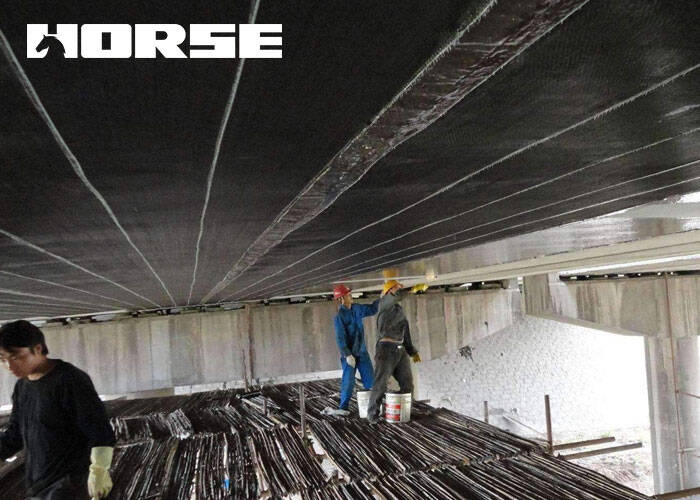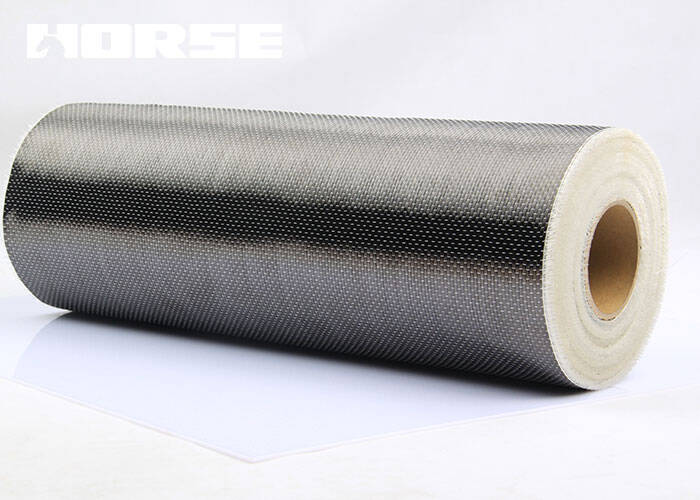Solutions
Horse Construction offers full range of structural strengthening materials with technical supports, documentation supports, products supports, project supports.
unidirectional carbon fiber in bridge reinforcement

With the rapid development of high-grade highways in my country, the mileage of highway bridges is also increasing. Due to various reasons, the bridge's bearing capacity is reduced, the concrete strength is reduced, or it is necessary to improve the seismic capacity and repair the cracks of the bridge. According to statistics, there are more than 5,000 dangerous bridges in my country's highway bridges, accounting for 20% of the total number of road bridges, and this proportion has a further upward trend. Facing the increasingly arduous task of reconstruction of highway reinforced concrete dangerous old bridges, it is urgent to find a fast, effective and reliable reinforcement and maintenance method. Unidirectional carbon fiber reinforced composite material strengthening concrete structure technology is a new, simple and efficient concrete structure strengthening technology, which is deeply valued by scholars at home and abroad, and has been widely used and developed.
1 Analysis of existing problems in bridge reinforcement engineering
Because bridges are special products built on the ground, they are not only affected by the natural environment (such as atmospheric corrosion, temperature, humidity changes, etc.), but also by the environment in which they are used. After the bridge has been used for a certain number of years, if the structure is old, aging, and damaged, it must be repaired to restore it to the original design bearing capacity. This makes the repair, maintenance, reinforcement and transformation of bridges inevitable. However, there are several problems in the process of strengthening the old bridge:
Because bridges open to traffic have realistic traffic needs, they must be reinforced without interrupting traffic, so there will be traffic interference during reinforcement.
Reinforcement generally must be carried out on the original structure, and can only make a fuss on this basis, so there are structural restrictions.
The perfect combination of new and old structures is a difficult problem, including changes and transitions between the new and old structures. Because most of the bridges that need to be reinforced are dangerous bridges, and their structures are in an unfavorable state, the reinforcement of old bridges is a huge challenge from all angles.
1. 1 economic analysis
Domestic experience in the reinforcement or reconstruction of old bridges shows that, under normal circumstances, the cost of bridge reinforcement is about 10% to 20% of the cost of a new bridge, and the cost of reinforcement and reconstruction of a double-curved arch bridge is about 20% to 40% of the cost of a new bridge. Therefore, bridge reinforcement can save a lot of investment and receive good social and economic benefits. Adopting appropriate reinforcement technology and widening measures can not only avoid the increase in engineering costs due to the removal of the old bridge and the reconstruction of the new bridge, but also restore and improve the carrying capacity and traffic capacity of the old bridge. Extend the service life of the bridge and meet the needs of modern transportation. At the same time, the reconstruction and reinforcement of bridges can not only improve the capacity and service level of highway bridges, but also eliminate hidden traffic safety hazards to a greater extent.
1. 2 Analysis from development
Highway bridge traffic mileage is also increasing. For various reasons, bridges have reduced bearing capacity, reduced concrete strength, or need to improve seismic capacity and repair bridge cracks. Carbon fiber cloth reinforcement technology can be applied. The bridge problem directly affects the normal function of the bridge, shortens the service life of the bridge, and even threatens the safety of passing people and vehicles. Therefore, the reinforcement of old highway bridges is conducive to promoting the sustainable development of bridge construction. It not only meets the needs of modern people without compromising the ability of future generations to meet their needs, but also enables the coordinated development of economy, society, resources and environmental protection.
1. 3 Analysis from design
In the early years, the guiding ideology of the design focused on material saving and low safety. Generally speaking, the cross-section is thin and the safety reserve is low. The most typical one is the double-curved arch bridge.
Bridges built in recent years, due to improper design or poor construction quality, also have problems with reinforcement. Some reinforcement requirements are that the bridge cannot bear the original design load requirements, and its original bearing capacity should be restored through reinforcement. There are also some load standards originally designed that cannot meet the current traffic requirements and need to be improved to a new standard.
In addition, because the original design of the middle and small bridges is not refined enough, and the design is generally not refined, the designer will have a sense of technical responsibility, and the safety will be greater than the accurate calculation, which can increase the structure and section leeway for the reinforcement afterwards.

2 Unidirectional carbon fiber is an ideal material for bridge reinforcement
2. 1 Basic characteristics
Carbon fiber is a fibrous carbon material. Carbon fiber cloth is a cloth-like material woven in a single direction from continuous carbon fibers with high strength and high elastic modulus.
2. 2 Chemical properties
The chemical structure of carbon fiber cloth is stable, and it is not corroded by acid, alkali, salt and various chemical media. It has good cold and heat resistance and is very suitable for use in the open air and in corrosive environments such as salt and alkali.
2. 3 construction performance
The carbon fiber cloth has a soft texture and can be adapted to various shapes of reinforced structures. At the same time, transportation and construction are very convenient, no large-scale equipment or other special facilities are needed, so the engineering cost can be greatly reduced, and the construction period can be effectively shortened.
3 Unidirectional carbon fiber material reinforcement principle
The carbon fiber sheet is pasted on the surface of the structure with a specially formulated epoxy resin. After the resin is cured, the carbon fiber and the original structure form a new force-bearing composite. The carbon fiber sheet is stressed together with the steel. Because the carbon fiber sheets share the load, the stress of the steel bars is reduced, and the concrete structure is strengthened.
The tensile strength of carbon fiber sheet is 3 400MPa, which is 7-10 times higher than steel. The modulus of elasticity is 23 500MPa~380 000MPa, which is similar to or slightly higher than that of steel bars. The elongation rate is 1.5%, which is lower than that of steel. Therefore, it has the ability to work with steel bars. Due to the use of epoxy resin materials with different proportions and different properties, the interface resin can be penetrated into the concrete, and the carbon fiber sheet is pasted closely to the shape of the member. The resin used for pasting has high bonding strength, which can effectively transfer the stress between the two materials and ensure that the bonding interface does not peel off.
4 Unidirectional carbon fiber sheet reinforcement construction process and construction points
Construction process: surface treatment of components-basic treatment-coating of primer-putty leveling-coating of the lower layer of epoxy resin-pasting of carbon fiber sheet-coating of the upper layer of epoxy resin-curing-protective coating .
Key points for carbon fiber paste construction: Use carbon fiber sheets and supporting resin glue according to design requirements. Mark the position of each layer on the surface to be pasted according to the design. Cut the carbon fiber cloth according to the design size. When it needs to be extended, the length of the joint should not be less than 15cm. The length of the blanking material meets the daily consumption.
5 Prospects for the application of Unidirectional carbon fiber materials
The application of carbon fiber reinforced bridges can achieve the expected effect of improving the bearing capacity. The carbon fiber material is light in weight, does not require any heavy equipment during construction, and is very thin and does not require a lot of space, especially when the engineering reinforcement space is tight, it can show this superiority.
Reinforcing reinforced concrete structures, using carbon fiber with high strength and high modulus of elasticity, can also achieve the same reinforcement effect as steel plates. But its structural weight has not increased, and its appearance is also light and beautiful. Use this technique. The reinforced structure has excellent durability. Because the reinforcement only uses carbon fiber and supporting resin, it will not rust, and has the properties of acid, alkali, salt and atmospheric corrosion resistance. Carbon fiber also has excellent chemical resistance and can effectively reduce the construction period. Its excellent characteristics have been proven. There are a large number of old bridges in our country that urgently need to be reinforced. Carbon fiber material is a composite material with high strength, light weight and good durability, and it is an ideal bridge reinforcement material. In view of the aging, damage, cracks and other problems existing in the currently operating bridges, based on the wide application of carbon fiber materials to strengthen the bridge technology, we continue to try and innovate, and use new technologies, new processes and new methods to make the reinforcement process faster, more economical, safer and more efficient. reliable. In the process of continuous improvement of bridge reinforcement technology, it has played a huge role in promoting the modernization of my country's transportation and better advocated the process of a harmonious society.
You can find anything here you are in need of, have a trust trying on these products, you will find the big difference after that.

High strength, unidirectional carbon fiber wrap pre-saturated to form a carbon fiber reinforced polymer (CFRP) wrap used to strengthen structural concrete elements.

High strength, unidirectional carbon fiber fabric pre-saturated to form a carbon fiber reinforced polymer (CFRP) fabric used to strengthen structural concrete elements.

High strength, unidirectional carbon fiber sheet pre-saturated to form a carbon fiber reinforced polymer (CFRP) sheet used to strengthen structural concrete elements.